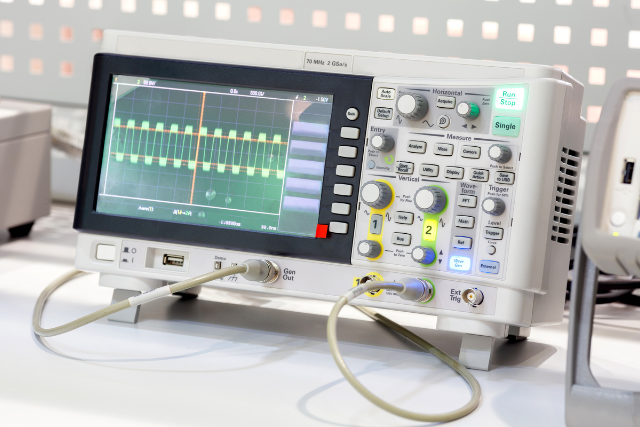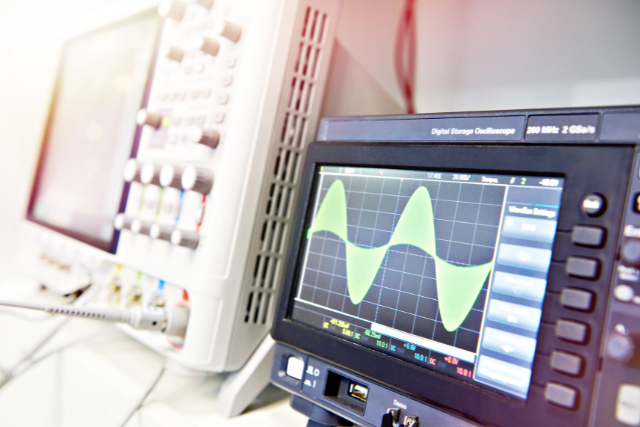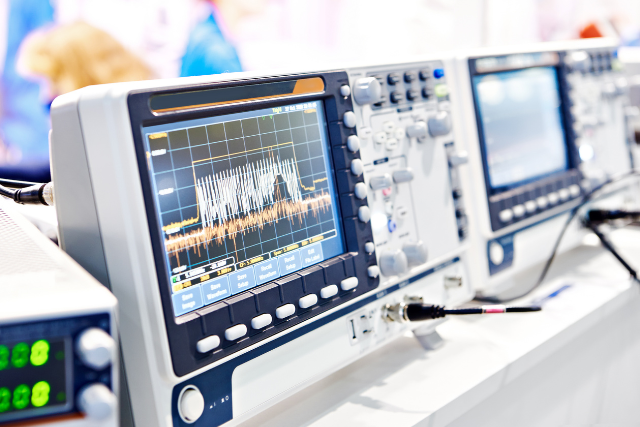Digital Storage Oscilloscopes (DSOs) are crucial tools in electronics, enabling engineers and technicians to visualize and analyze electronic signals.
They provide many functionalities that make them indispensable in developing and troubleshooting electronic devices.
Understanding Digital Storage Oscilloscopes (DSOs)
A Digital Storage Oscilloscope (DSO) is an electronic instrument that captures, stores, and analyses electrical signals. Unlike traditional analog oscilloscopes, DSOs convert the incoming signal into digital form and store it in memory, allowing for detailed analysis and long-term storage.
How do DSOs work?
DSOs operate by sampling an input signal at regular intervals and converting these samples into digital data using an analog-to-digital converter (ADC). This digital data is then stored in memory and can be displayed on a screen for analysis.
Key Components of DSOs
DSOs are composed of several critical components that work together to capture and analyze signals:
- Analog-to-Digital Converter (ADC): Converts the analog input signal into a digital format.
- Memory: Stores the digitized signal data for later retrieval and analysis.
- Display: Shows the captured signal waveform and measurement results.
- Trigger System: Stabilizes the display of repetitive waveforms and captures transient events.
- Processing Unit: Analyzes the stored data and performs various calculations and measurements.

Advantages of DSOs over Analog Oscilloscopes
DSOs offer several advantages over traditional analog oscilloscopes, making them the preferred choice for many applications:
Enhanced Storage Capabilities
One of the primary benefits of DSOs is their ability to store captured waveforms in digital memory. This allows for long-term storage and the ability to recall and analyze past signals.
Advanced Analysis Features
DSOs have advanced analysis features such as FFT (Fast Fourier Transform), automated measurements, and waveform math functions. These features enable detailed signal analysis and troubleshooting.
High Sampling Rates and Bandwidth
Modern DSOs offer high sampling rates and bandwidth, allowing for accurate capture and analysis of high-frequency signals. This is particularly important in RF (Radio Frequency) applications and digital communications.
Portability and User-Friendly Interface
Many DSOs are designed to be portable, with compact sizes and lightweight designs. Additionally, they often feature user-friendly interfaces with touchscreens and intuitive controls, making them accessible to users of all skill levels.
Table 1: Comparison of DSOs and Analog Oscilloscopes
| Feature | Digital Storage Oscilloscope (DSO) | Analog Oscilloscope |
|---|---|---|
| Signal Storage | Digital memory | No storage |
| Analysis Features | Advanced (FFT, automated measurements) | Limited |
| Sampling Rate and Bandwidth | High | Lower |
| Portability | Portable and lightweight | Generally larger and heavier |
| User Interface | User-friendly, touchscreen options | Manual controls |
Applications of DSOs
DSOs are versatile instruments used in various applications across different electronics and electrical engineering fields.
Research and Development
In research and development (R&D) settings, DSOs are essential for designing and testing new electronic devices. They help engineers analyze signal integrity, timing issues, and circuit performance.
Education and Training
DSOs are widely used in educational institutions to teach students about electronic signal analysis. Their user-friendly interface and advanced features make them ideal for demonstrating complex concepts in electronics.
Manufacturing and Quality Control
DSOs are used in manufacturing environments for quality control and testing electronic components and systems. They help identify defects, ensure compliance with specifications, and verify the performance of finished products.
Telecommunications
DSOs are crucial in the telecommunications industry for analyzing and troubleshooting communication signals. They help ensure the integrity and reliability of signals in systems such as cellular networks and internet infrastructure.
Automotive Electronics
In automotive electronics, DSOs diagnose and troubleshoot vehicle electrical systems. They help identify issues with sensors, control units, and communication networks within the vehicle.
Medical Electronics
DSOs play a significant role in the development and testing of medical devices. They help ensure the accuracy and reliability of signals in devices such as pacemakers, diagnostic equipment, and monitoring systems.

Choosing the Right DSO
When selecting a DSO, several factors need to be considered to ensure it meets the specific requirements of the intended application.
Bandwidth and Sampling Rate
Bandwidth and sampling rate are critical parameters determining the DSO’s ability to capture and display high-frequency signals accurately. Higher bandwidth and sampling rates are necessary for applications involving fast signals.
Memory Depth
Memory depth refers to the amount of data the DSO can store. A deeper memory allows for more extended signal capture and more detailed analysis. This is important for applications requiring long-duration signal monitoring.
Number of Channels
The number of channels indicates how many signals the DSO can capture simultaneously. Multi-channel DSOs help analyze multiple signals in complex systems, such as multi-phase power supplies or communication networks.
Display and User Interface
A clear and intuitive display is essential for practical signal analysis. Touchscreen interfaces and high-resolution displays enhance usability and make navigating various functions and settings more accessible.
Connectivity and Software
Modern DSOs often have connectivity options such as USB, Ethernet, and Wi-Fi, allowing for easy data transfer and remote control. Additionally, software compatibility for data analysis and reporting is an important consideration.
Table 2: Key Factors in Choosing a DSO
| Factor | Importance |
|---|---|
| Bandwidth | Affects the accuracy of signal capture |
| Sampling Rate | Allows for more extended signal capture and detailed analysis |
| Memory Depth | Allows for longer signal capture and detailed analysis |
| Number of Channels | Enables simultaneous capture of multiple signals |
| Display and Interface | Enhances usability and ease of navigation |
| Connectivity and Software | Facilitates data transfer and remote control |
Technological Advancements in DSOs
The field of digital storage oscilloscopes is continuously evolving, with technological advancements enhancing their capabilities and expanding their applications.
Real-Time Signal Processing
Modern DSOs incorporate real-time signal processing features that allow for immediate analysis and display of captured signals. This is particularly useful for identifying transient events and glitches.
Enhanced Triggering Systems
Advanced triggering systems enable precise capture of specific signal events. Features such as pattern triggering, sequence triggering, and advanced edge triggering improve the accuracy and reliability of signal analysis.
Multi-Domain Analysis
Some DSOs offer multi-domain analysis capabilities, allowing users to simultaneously analyze signals in both the time and frequency domains. This is beneficial for comprehensive signal characterization and troubleshooting.
Integration with Other Test Equipment
DSOs can be integrated with other test equipment, such as logic analyzers, spectrum analyzers, and function generators. This integration enhances the versatility of DSOs and allows for more comprehensive testing and analysis.
Portable and Handheld Models
Technological advancements have led to the development of portable and handheld DSOs. These models offer the same advanced features as benchtop DSOs but are compact and portable, making them ideal for field work and on-site testing.

FAQs
1. What is a Digital Storage Oscilloscope (DSO)?
A Digital Storage Oscilloscope (DSO) is an electronic instrument that captures, stores, and analyses electrical signals. It converts analog signals into digital data stored in memory and displayed on a screen for detailed analysis.
2. How does a DSO differ from an analog oscilloscope?
DSOs differ from analog oscilloscopes in converting signals into digital form and storing them in memory. This allows for advanced analysis features, long-term storage, and higher accuracy in capturing high-frequency signals.
3. What are the key components of a DSO?
The key components of a DSO include an analog-to-digital converter (ADC), memory for storing digitized data, a display for showing waveforms, a trigger system for stabilizing signals, and a processing unit for analysis.
4. What should I consider when choosing a DSO?
When choosing a DSO, consider bandwidth, sampling rate, memory depth, number of channels, display and user interface, and connectivity options. These factors will determine the DSO’s suitability for your specific application.
5. What are some typical applications of DSOs?
Typical applications of DSOs include research and development, education and training, manufacturing and quality control, telecommunications, automotive electronics, and medical electronics. They are used for signal analysis, troubleshooting, and quality assurance.
6. How have DSOs advanced in recent years?
Recent advancements in DSOs include real-time signal processing, enhanced triggering systems, multi-domain analysis, integration with other test equipment, and the development of portable and handheld models. These advancements have expanded their capabilities and applications.
Conclusion
Digital Storage Oscilloscopes (DSOs) are indispensable tools in electronics, offering advanced functionalities for capturing, storing, and analyzing electrical signals.
With their ability to convert analog signals into digital data, DSOs provide enhanced storage capabilities, advanced analysis features, and higher accuracy compared to traditional analog oscilloscopes.
They are widely used in various applications, including research and development, education, manufacturing, telecommunications, automotive, and medical electronics.







